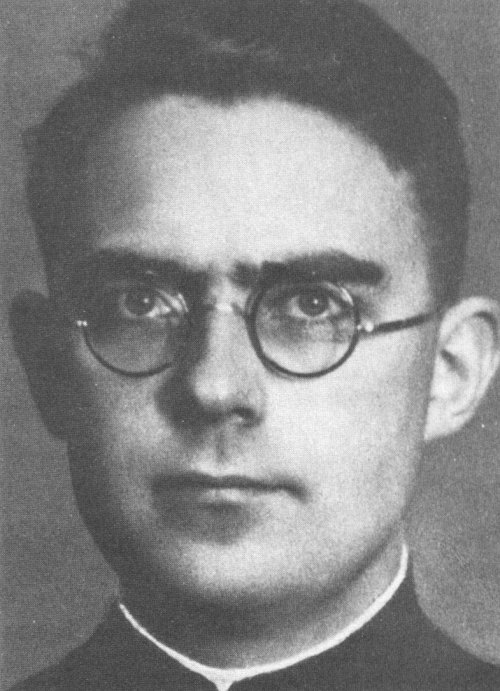Search for Names, Places and Biographies
Already layed Stumbling Stones
Suche
Hermann Lange * 1912
Holstenglacis 3 (Untersuchungsgefängnis) (Hamburg-Mitte, Neustadt)
1942 verhaftet
enthauptet 10.11.1943
- http:/
/ de.wikipedia.org/ wiki/ L%C3%BCbecker_M%C3%A4rtyrer
(Lübecker Märtyrer auf Wikipedia) - http:/
/ www.erzbistum-hamburg.de/ ebhh/ Lueb_maertyrer/ chronik.php
(Internetseite des Erzbistums Hamburg) - http:/
/ www.luebeckermaertyrer.de/ de/ index.html
(Informationsseite der Geschäftsstelle Lübecker Märtyrer)
further stumbling stones in Holstenglacis 3 (Untersuchungsgefängnis):
Heinz Jäkisch, Bernhard Jung, Karl-Heinz Keil, Eduard Müller, Johann Odenthal, Johannes Prassek, Rudolf Schöning, Karl Friedrich Stellbrink, Walter Wicke, Walerjan Wróbel
Hermann Lange, born on 16 Apr. 1912 in Leer, executed on 10 Nov. 1943 in the Hamburg-Stadt pretrial detention facility
Holstenglacis 3 (in front of the pretrial detention facility)
Hermann Lange, the son of a navigation teacher, had grown up in well-off and sheltered circumstances with four siblings in Eastern Friesland. After the birth of their youngest son, his parents, Christian Joseph Lange (born in 1877) and Lenore Hermine, née Suerken (born in 1881), had moved with the older children Hans (born in 1907), Angela (born in 1906) and Maria (born in 1909) from Leer to Emden, where another son, Paul was born (in 1915).
The family returned to Leer in 1919, to Mörkenstrasse 6. Hermann Lange completed the Catholic eight-grade elementary school (Volksschule) and joined the Catholic youth movement "Bund Neudeutschland,” which regarded itself as a link between the church and intellectuals. After graduating from high school (Abitur), he began studying theology at the University of Münster in 1933. On 17 Dec. 1938, he was ordained a priest in Osnabrück Cathedral. After substituting in a parish and working as a curate, he was appointed vicar at the Herz-Jesu Church in Lübeck on 1 June 1939. Hermann Lange was described as a highly educated and well-read theologian who concentrated on youth work and left a deep impression with his seriousness, reliability, and sophisticated sermons. In discussion circles, he expressed himself critically about the war and abhorred the German violent crimes in the occupied territories. He took part in the reproduction and distribution of flyers critical of the regime, which contained, among other things, the sermons of the Münster Bishop von Galen. (Clemens August Graf von Galen’s (born in 1878, died in 1946) sermons against the murder of "unproductive fosterlings” contributed to the fact that in Aug. 1941, the initial patient murders under the designation of "Operation T4” were officially stopped.)
When he was arrested on 15 June 1942, Hermann Lange did not deny his activities. After almost a year in the Lauerhof and Fuhlsbüttel prisons, Hermann Lange was sentenced to death on 23 June 1943 in the "Lübeck Christian Trial” together with the Catholic clergymen Eduard Müller and Johannes Prassek as well as the Protestant pastor Karl Friedrich Stellbrink by the "People’s Court” (Volksgerichtshof), which had traveled from Berlin to Lübeck. The charges were "undermining of military strength” ("Zersetzung der Wehrkraft”) and "preparation to high treason” ("Vorbereitung zum Hochverrat”). After the sentencing, the four clergymen were transferred to the pretrial detention center in Hamburg, where they awaited execution of the sentences. A petition for clemency has been rejected.
On 10 Nov. 1943, they received the news at noon: "Today at 6 p.m. execution of the sentence. Death by decapitation.” Since the beginning of the war, executions in the courtyard of the pretrial detention facility no longer took place in the early hours of the morning, but in the evening.
Eduard Müller, Hermann Lange, Johannes Prassek, and finally, Karl Friedrich Stellbrink each died three minutes apart. "Their blood literally flowed into each other,” wrote biographer Else Pelke in her book Der Lübecker Christenprozess 1943.
The mortal remains of Hermann Lange and Karl Friedrich Stellbrink were cremated in the Ohlsdorf crematorium. The urn of Hermann Lange is today in the crypt of the Propsteikirche zu Lübeck, that of Karl Friedrich Stellbrink in the Lutherkirche. The mortal remains of Johannes Prassek and Eduard Müller are said to have been cremated in the crematorium of Neuengamme, where they were scattered in the "camp nursery” there.
Since 1988, a commemorative plaque on the wall of the pretrial detention facility in Hamburg’s ramparts has been commemorating their execution. On 25 June 2011, the "Four Lübeck Martyrs,” the Catholic chaplains Müller, Lange, and Prassek were beatified in Lübeck. The Protestant Pastor Friedrich Stellbrink was honored during the festivities. In Hamburg’s Allermöhe district, the Hermann-Lange-Weg was named after him. Two other streets bear his name in Lübeck and Leer.
Translator: Erwin Fink
Kindly supported by the Hermann Reemtsma Stiftung, Hamburg.
Stand: May 2020
© Susanne Rosendahl
Quellen: StaH 242-1 II Gefängnisverwaltung II, Ablieferung 1998/1; StaH 332-5 Standesämter 1167 u 733/1943; Gedenkstätte Deutscher Widerstand, http://www.gdw-berlin.de/vertiefung/biografien/personenverzeichnis/biografie/view-bio/hermann-lange/?no_cache=1 (Zugriff 16.3.2016); http://www.unitas-ruhrania.org/index. php?page=126 (Zugriff 16.3.2016); http://www.luebeckermaertyrer.de/de/index.html (Zugriff 16.3.2016); Pelke: Christenprozess; Voswinkel: Geführte Wege.


